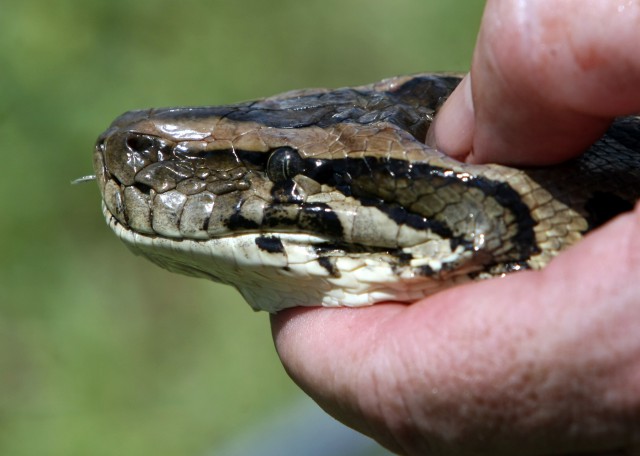
A new report from the U.S. Geological Survey warns that populations of “giant invasive snakes” have gained ground in the United States and pose a serious threat.
We saw the headline and immediately pictured snakes on a plane, too.
Turns out, all nine non-native snake species that were examined in the study pose a significant risk — to the health of U.S. ecosystems. Whew! It’s just the ecosystems; they’re not eating people.
Well, a few of them have been known to kill people, but that is quite rare. The snake most associated with unprovoked human fatalities in the wild is the reticu lated python, which attacks people about as often as alligators do.
Five of the species — Burmese pythons, boa constrictors, yellow anacondas and northern and southern African pythons — were rated as being a high risk, primarily because they eat vulnerable native species, like, well, pretty much anything smaller than humans. The report says they eat “most native birds and mammals,” which really narrows it down.
South Florida is the place to avoid if you don’t want to run into one of these babies, which can be longer than 20 feet and weigh more than 200 pounds.
Apparently, the reticulated python and the anaconda have been found in the wild in Florida, although breeding populations have not yet been confirmed for either. On the other hand, breeding populations have been confirmed there for Burmese pythons and the boa constrictor, and possibly the northern African python.
The report says there are no effective tools for eradicating an established population of giant snakes over a large area, in part because their colors camouflage them and make them difficult to find.
Scientists say Guam is a good example of why non-native snakes are not welcome: Within 40 years of its arrival, the brown treesnake had decimated 10 of the island’s 12 native forest birds, one of its two bat species and about half of its native lizards.
Hair crisis at CU
AXE, the company that makes hair products for men, has declared a “hair crisis” and is deploying a “hair crisis relief center” to the Buffs Barber Shop in Boulder Oct. 26–30.
As part of its crisis management effort, AXE wants media outlets to help guys with follicular challenges by getting readers involved.
The company is advising us to do everything from having readers nominate male CU students who are in major need of a hair makeover to surveying campus ladies about the most popular hair styles for men.
Oh, and we’re supposed to encourage male students to visit the crisis relief center.
Um, sounds like a lot of work to do in the name of hair product sales.
Anyway, you’ve been forewarned about this looming epidemic.
Good news for pot smokers
All in all, not a bad week for weed. First, Boulder County District Attorney Stan Garnett dropped the charges against a 35-year-old pregnant caregiver in Nederland who had been charged with felony marijuana crimes after a July 2008 raid on her house uncovered 50 marijuana plants.
Sherri Versfelt was serving as the caregiver for a patient with a debilitating medical condition, according to the Cannabis Therapy Institute, and was scheduled to go to trial this week.
Then, the Obama administration announces that federal agents will no longer go after legitimate medical marijuana distributors in states that allow the use of pot for medicinal purposes.
And a Gallup poll released on Oct. 19 found that U.S. support for legalizing marijuana has reached an all-time high of 44 percent, according to the Colorado pro-marijuana group SAFER (Safer Alternative for Enjoyable Recreation).
Finally, Gary Lindstrom of Breckenridge, a former state representative, county commissioner and undersheriff who has 31 years of experience in law enforcement, threw his support behind a Breckenridge ballot measure to decriminalize marijuana in the town.
There was one spot of bad news last week for pot proponents: The Erie Board of Trustees added that town to the list of local communities that have placed a moratorium on issuing licenses to medical marijuana dispensaries.












